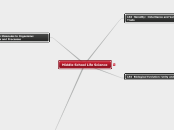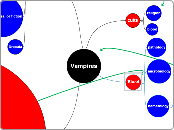Floating topic
The Hierarchy in Organization of . Living Things
Circulatory System
The system that transports oxygen and nutrients throughout the body and carries away wastes
The heart pumps blood
The blood travels to large arteries
Then travels to the small vessels
Blood exchanges many substance with the surrounding tissues
Blood flows into the veins
Blood returns back into the heart, process repeats
Heart
Made up of tissues
Cardiac Muscle Tissue
Makes the heart contract and moves the blood around the body
Nerve Tissue
Connective Tissue
Blood vessels
Types
Arteries
Veins
Carry blood away from the heart
Capillaries
Tiny blood vessels with very thin walls which allow substances to diffuse between the blood and other body fluids and tissues
Blood
Type of Protein
Plasma
A protein- rich liquid that carries the blood cells along and makes up over half of blood's volume
Types of Blood Cells
Platelets Cells
Tiny cells that help in blood clotting
White Bell Cells
These are infection- fighting cells in the blood which recognize and destroy invading bacteria and viruses
Red Blood Cells
Contains a protein called hemoglobin, which allows them to transport oxygen throughout the body
Digestive System
Organ system which both chemically and mechanically break down food to release nutrients molecules for our body to absorb and use
Digestion
When you eat, you swallow and your tongue pushes the food into your throat.
Digestion-Breaks food down into useful nutrients
Salvary Glands
Esophagus
Once you begin swallowing, the food begins to move down your esophagus
Stomach
Food enters your stomach, the stomach muscles mix the food and liquid then slowly empties its liquids, called chyme
Absorption-Nutrients move into the bloodstream
Liver
The food then eneters the small intestine. The muscles of the small intestine mix food with digestive juices from the pancreas, liver, and intestine, and push the mixture forward.
Pancreas
Appendix
Small Intestine
Large Intestine
Moving into the large intestine, the large intestine absorbs water and changes the waste from liquid into stool
Anus
To food moves down to the rectum, stores stool until it pushes stool out of your anus
Elimination-Leftover waste is removed from the body
Rectum
Respiratory system
Organ system provides oxygen for the body and allows carbon dioxide to leave the body
Stages
Air first begins to enter our body from our mouth and nose
Passes through the pharynx
Travels down the trachea
Trachea Support
Trachea is supported by many rings of cartilage. The cartilage keeps the trachea open to allow air to flow freely. It is a special type of connective tissue with specialized cells mixed in a mix of strong and flexible fibres.
Trachea divides into 2 bronchus known as the bronchi
Organs
Mouth
Nose/ Nasal Cavity
Pharynx
Trachea
Bronchi
Lungs









